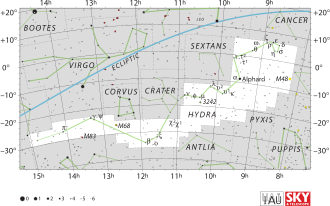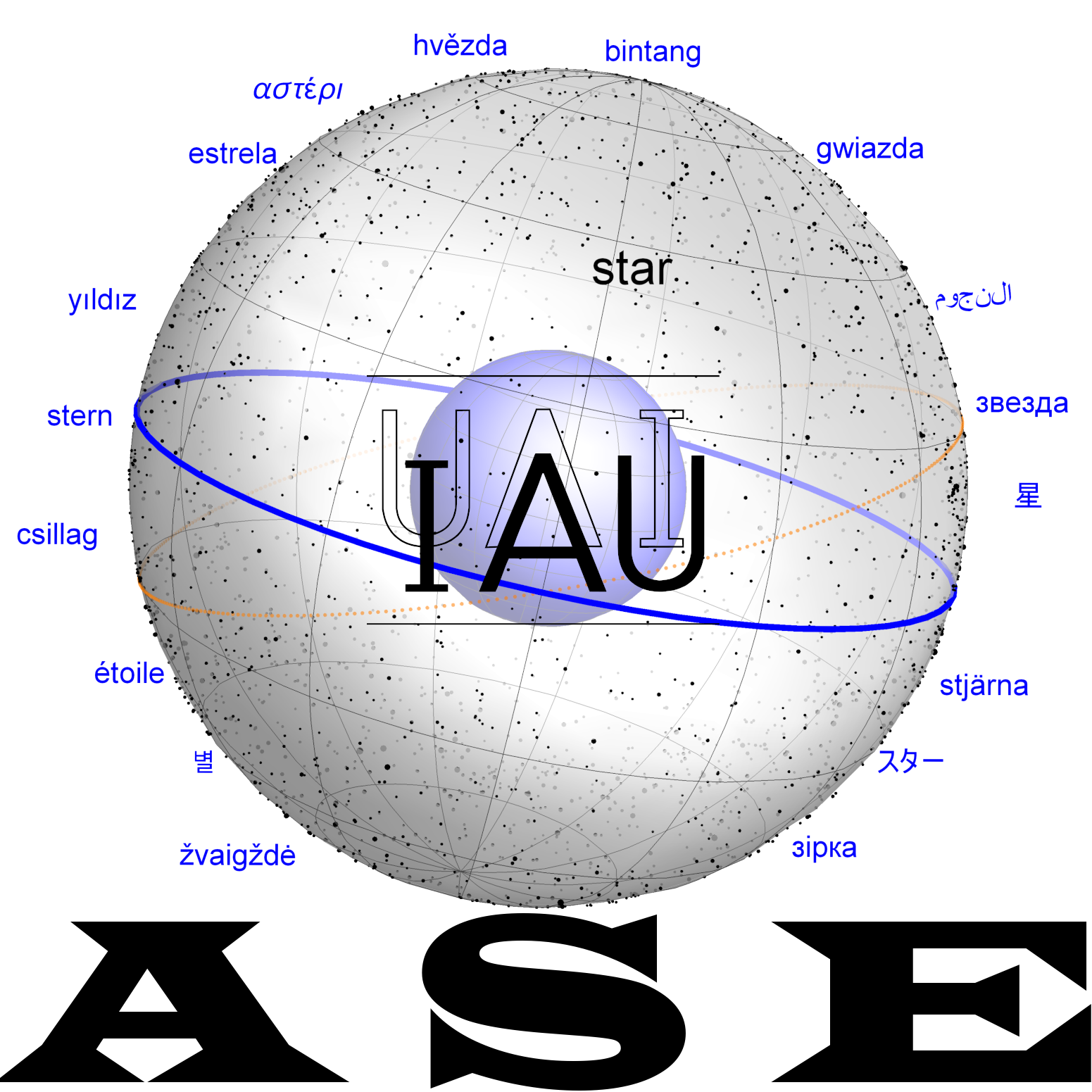Hydra: Difference between revisions
No edit summary |
|||
| Line 9: | Line 9: | ||
==== Aratus ==== |
==== Aratus ==== |
||
The Greek poet Aratus has many Babylonian references; some of them hidden. For him, this constellation is a (Greek) watersnake. |
The Greek poet Aratus has many Babylonian references; some of them hidden. For him, this constellation is a (Greek) watersnake. |
||
* [443] Another constellation trails beyond, which men call the Hydra. Like a living creature it winds afar its coiling form. Its head comes beneath the middle of the Crab, its coil beneath the body of the Lion, and its tail hangs above the Centaur himself. Midway on its coiling form is set the Crater, and at the tip the figure of a Raven [Corvus] that seems to peck at the coil. |
|||
* [449] There, too, by the Hydra beneath the Twins brightly shines Procyon. [51x] and the coil of the gleaming Hydra: in it, too, the dim-lit Crater and the Crow and the scanty-starred Claws and the knees of Ophiuchus are borne. |
|||
* [595] Up rises the Hydra’s head and the bright-eyed Hare and Procyon and the forefeet of the flaming dog. |
|||
* [600] The Hydra rises higher as far as Crater, and before her the Dog brings up his hind feet, dragging behind him the stern of Argo of many stars. |
|||
* [607] Nor can the rising Claws [Libra], though faintly shining, pass unremarked, when at a bound the mighty sign of Boötes rises, jeweled with Arcturus. Aloft is risen all of Argo, but the Hydra, shed as she is afar over the heavens, will lack her tail. |
|||
* [663] So she is borne towards the West, but other signs in the East the vault of heaven brings from below, the remaining half of the Crown and the tail of the Hydra, and uplifts the body and head of the Centaur and the Beast that the Centaur holds in his right hand. But the fore-feet of the Centaur-Knight await the rising of the Bow. => pi Hya gehört für Aratus dazu But she sinks beneath the verge the coiling neck and all the brow of the gleaming Hydra. |
|||
* [700] Yet many a coil of the Hydra remains, but Night engulfs her wholly with the Centaur, when the Fishes [Pisces] rise; with the Fishes the Fish which is placed beneath azure Aegoceros rises |
|||
==== Eratosthenes ==== |
|||
==== Hipparchus ==== |
==== Hipparchus ==== |
||
Revision as of 18:38, 4 March 2025
One of the 88 IAU constellations. The name "Hydra" refers to a watersnake from Greek mythology. Still, the underlying constellation originally referred to a Babylonian creature that consisted of a dog-headed snake with wings, the MUŠ.
Etymology and History
The Greek constellation of the Water Snake is a derivative of the Babylonian constellation of the MUŠ-Dragon, a dog-headed creature with the body of a gigantic snake with front legs and wings.
Origin of Constellation
The Babylonian constellation is mentioned as early as 2nd millennium BCE; it occurs in lexical texts and texts of the Three Stars Each-genre. It is also mentioned in the first list (uranology) of MUL.APIN, where the Raven (or Crow) is mentioned at the tip of tail of the huge creature in the sky.
Aratus
The Greek poet Aratus has many Babylonian references; some of them hidden. For him, this constellation is a (Greek) watersnake.
- [443] Another constellation trails beyond, which men call the Hydra. Like a living creature it winds afar its coiling form. Its head comes beneath the middle of the Crab, its coil beneath the body of the Lion, and its tail hangs above the Centaur himself. Midway on its coiling form is set the Crater, and at the tip the figure of a Raven [Corvus] that seems to peck at the coil.
- [449] There, too, by the Hydra beneath the Twins brightly shines Procyon. [51x] and the coil of the gleaming Hydra: in it, too, the dim-lit Crater and the Crow and the scanty-starred Claws and the knees of Ophiuchus are borne.
- [595] Up rises the Hydra’s head and the bright-eyed Hare and Procyon and the forefeet of the flaming dog.
- [600] The Hydra rises higher as far as Crater, and before her the Dog brings up his hind feet, dragging behind him the stern of Argo of many stars.
- [607] Nor can the rising Claws [Libra], though faintly shining, pass unremarked, when at a bound the mighty sign of Boötes rises, jeweled with Arcturus. Aloft is risen all of Argo, but the Hydra, shed as she is afar over the heavens, will lack her tail.
- [663] So she is borne towards the West, but other signs in the East the vault of heaven brings from below, the remaining half of the Crown and the tail of the Hydra, and uplifts the body and head of the Centaur and the Beast that the Centaur holds in his right hand. But the fore-feet of the Centaur-Knight await the rising of the Bow. => pi Hya gehört für Aratus dazu But she sinks beneath the verge the coiling neck and all the brow of the gleaming Hydra.
- [700] Yet many a coil of the Hydra remains, but Night engulfs her wholly with the Centaur, when the Fishes [Pisces] rise; with the Fishes the Fish which is placed beneath azure Aegoceros rises
Eratosthenes
Hipparchus
The mathematical astronomer mentions this constellation rising and setting.
- The first star rising is ,
- the last star rising is the one at the tip of the tail (ὁ ἐν ἄκρᾳ τῇ οὐρᾷ)
Almagest
Transfer and Transformation of the Constellation
Mythology
Greek/ Greco-Roman folklore
Babylonian belief
IAU WGSN
The star pi Hydrae is very important in history as it is one of the keywitnesses for transfer from Hipparchus to Ptolemy.
- name in Hipparchus: ὁ ἐν ἄκρᾳ τῇ οὐρᾷ (the one at the farthest point of the tail)
- name in the Almagest: ὁ ἐπ᾽ἄκρας τῆς οὐρᾶς (the one at the end of the tail)
The Greek term ἄκρᾳ can be translated as "at the farthest point" or "at the end" (or "hightest" which doesn't apply here).








